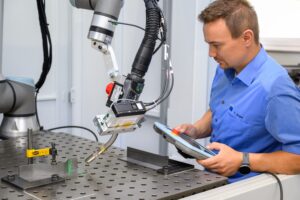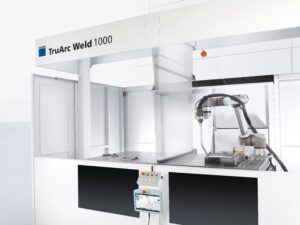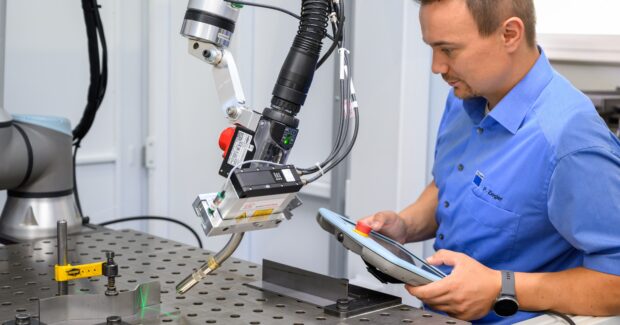Cobotic Welding Gets Serious
With the addition of intelligent functionality, cobotic arc-welding cells are only becoming more profitable for any shop to operate.
Posted: November 12, 2024

Within the last few years collaborative robots, or cobots for short, have become more and more commonplace in manufacturing operations. Due to the extremely simple programming method and their ability to work closely with humans (hence collaboratively) they can be deployed for just about any repetitive task in a factory without a lot of setup effort.
The application of cobots to simple production tasks is limited mainly by the reach and payload capacity of the cobot, which is necessarily lower than an industrial robot to make it safer for people who work nearby. In contrast to cobots, a very large and heavy robot with a lot of reach and the motor power required to lift heavy loads will also be far too powerful to notice the small amount of resistance of a human being in the way and will require extensive safeguarding to reduce the chance of an injury. This clearly means the industrial robot system will be bigger, and eat up more factory floor, but it also means that programming of the robot must be done more deliberately and slowly. Cobots, with their inherent safety advantage, can be trained to do new jobs more rapidly and intuitively. This fast setup time and ease of use for new operators has given cobots a very obvious application in automated arc welding, and this has rapidly become one of the main growth areas for the technology in fabrication shops across North America.

Most fabrication shops, almost regardless of business focus or even geographical location within North America, can utilize a cobot arc welding system immediately. These systems provide an instant boost to welding output without requiring the addition of extremely specialized personnel or a significant training period to get a new operator producing good quality welds. Paired with a programmable welding power supply, different welding power parameters for different types of seams can be preset, stored, and then called up as needed by the person programming new jobs on the cobot. This means in practice that the operator of the weld cell does not need much understanding of the welding process to create and run new welding jobs all day long. As a result, most shops adopting this technology have also adopted an operational model where simple parts are routed to the cobot arc welder and more complicated welding jobs that would take longer to program or require a higher-skill welder to setup, flow toward hand-welding operations.
This situation represents a big step forward for many sheet metal factories: More welding production can be achieved with the same number of available hands, and employees can be cross trained to tackle different fabrication steps in a much shorter timeframe without a complicated apprenticeship.
Tech Broadens More Complex Joining Without Sacrificing Fast Setup
It also brings with it a new set of limitations though. Things tend to slow way down, or even grind to a halt, when we try to set up more difficult welding jobs with lots of seams, tricky approach angles, or parts with non-linear geometry, for example a joint that changes angle along the weld seam. For a number of years now this rough division between “simple” and “complex” welding jobs has defined the area of application for cobot welding cells. That said, an exciting new technology development is aimed directly at broadening the applicability of cobot welding into more complex joining situations without sacrificing the flexibility and fast setup that the cobotic welding system brings.
Smart Seam Tracking technology utilizes an optical sensing system mounted directly to the cobot arm to give the cobotic welder a very simple sort of “vision” capability. The team member setting up the cobot with Smart Seam Tracking doesn’t program the welding seams with point-to-point movements of the cobot arm in the usual way. Instead, the various joints are programmed by aligning the cobot to the beginning of the weld seam, and then triggering Smart Seam Tracking to engage. The optical system detects the material edges that it is being directed toward, and then, as the name implies, tracks the seam automatically until it detects the end of the joint. This has the obvious benefit that it can increase the programming productivity for assemblies with a lot of joints: Less time manually positioning and teaching the seam positions means more time producing!
In addition, this technology can allow the user to more easily set up the cobot to tackle complex geometries that would be very tricky to program with point-to-point movements, like oval or compound-curve weld seams. This brings a whole new range of part assemblies into the wheelhouse of the cobot arc welder, allowing more fabrication work to flow through cobot cells instead of absolutely requiring a manual process.
Cobot welding cells are an incredibly powerful tool that almost any scale of fabrication enterprise can easily adopt, integrate, and generate profit from. With the addition of novel intelligent functions such as Smart Seam Tracking, the ease-of-use of the cobot welding concept is further expanded to cover a wider range of jobs. The trend in this business field is toward making cobots completely general-purpose fabrication tools that can be used for just about any welding job and by just about any member of a factory floor team. For many people joining the fabrication workforce, learning to manage a cobot welding cell will be more attractive and rewarding work than trying to master welding with a handheld torch.
It will also be inherently safer, and tend to produce more consistent results, than any manual welding operation can. All things considered; the implication here certainly is that every fabrication shop with welding work on its hands should be looking hard at this technology. Aside from the obvious need for some capital expenditure, these systems bring a host of benefits without any drawbacks. With the addition of intelligent functionality like Smart Seam Tracking, cobotic arc-welding cells are only becoming more profitable for any shop to operate.

















